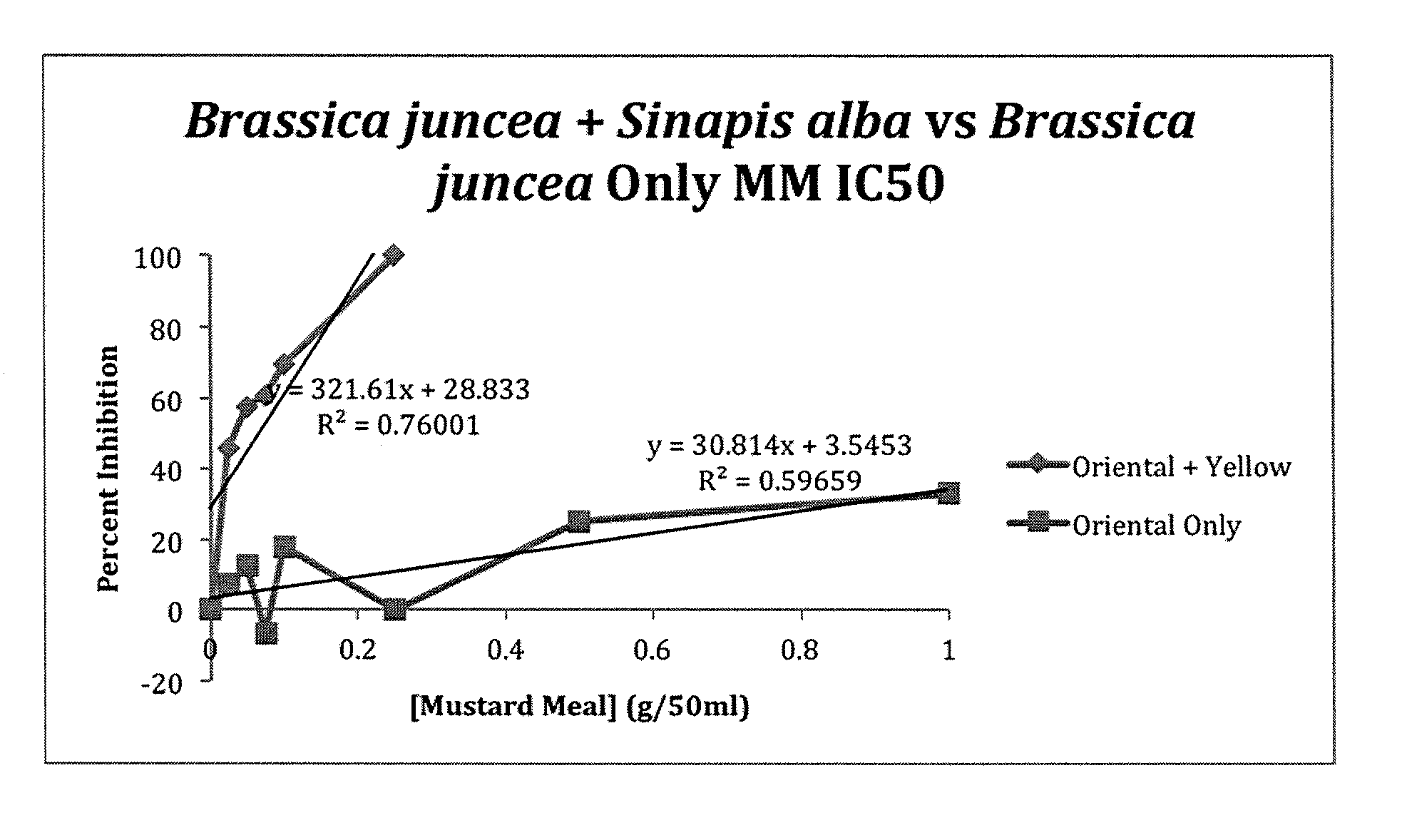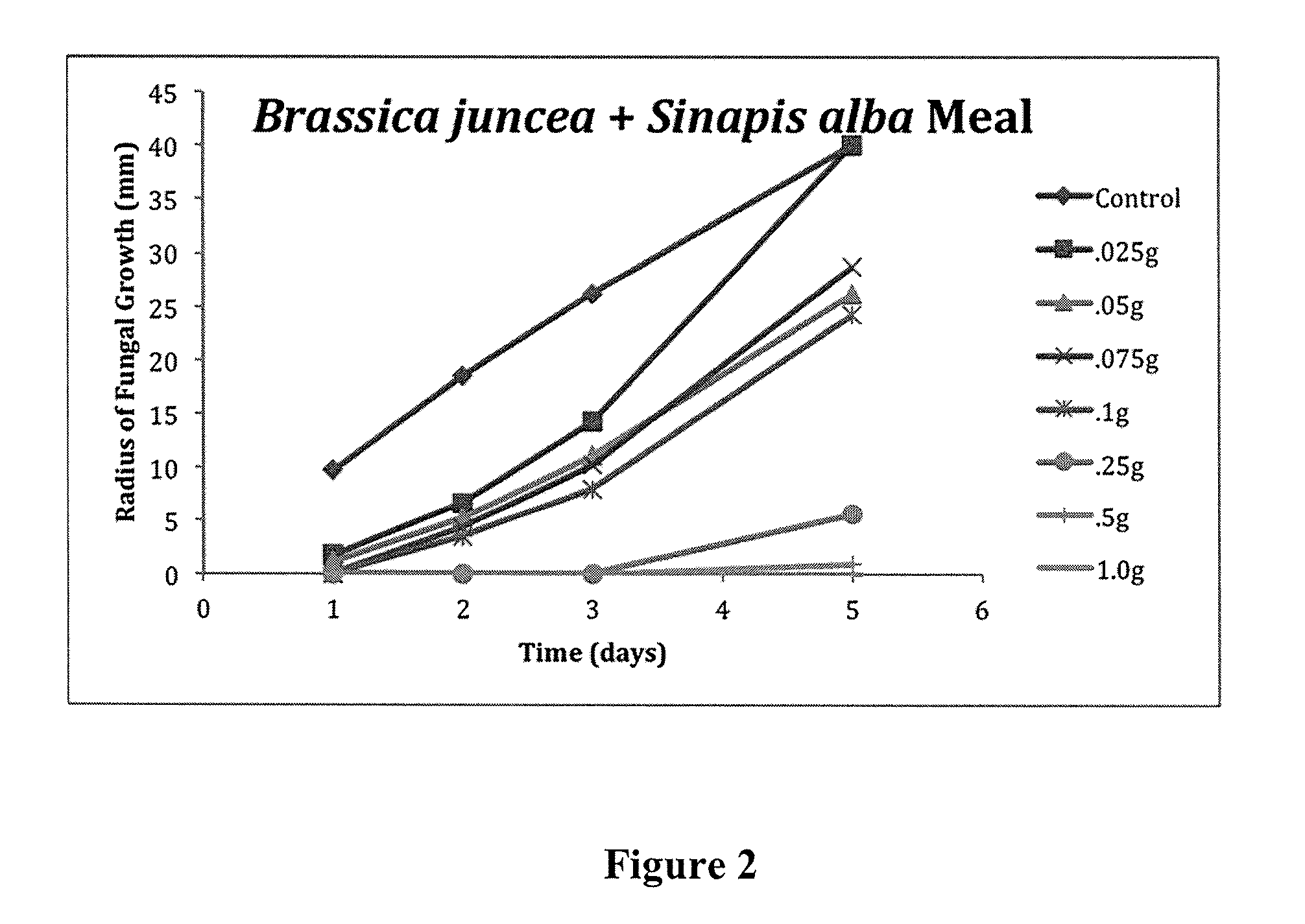Mixtures of mustard plant material for the control of pests and methods of making
a mustard plant material and pest control technology, applied in the field of mustard plant material, can solve the problems of non-target organisms, affecting the stratospheric ozone layer, and causing damage to fish and birds of prey
- Summary
- Abstract
- Description
- Claims
- Application Information
AI Technical Summary
Benefits of technology
Problems solved by technology
Method used
Image
Examples
example 1
Preparing Mustard Plant Material Obtained from Brassica juncea and a Mustard Plant Material Mixture Obtained from Brassica juncea / Sinapis alba
[0052]One metric ton of Brassica juncea mustard seed was dried using a Vertec grain dryer, model VT5000 set at a temperature not exceeding 55° C., yielding approximately 985 kg of dried mustard seed having a moisture content of 6.5%. The dried mustard seed was subsequently cleaned using a Damas screen Model 640 ana, yielding approximately 960 kg of seed. The cleaned seed was then subjected to a de-oiling process using a Taby Type 90 oil expeller. The de-oiling process was carried out maintaining a temperature of less than 55° C. and provided seed meal comprising 30% of the total available seed oil content, yielding approximately 672 kg of the Brassica juncea alba seed meal. To the de-oiled meal 16 kg of sucrose and 134 kg of Brassica juncea bran was added and the formulation was then mixed using a Munson ribbon blender, model 210 yielding a m...
example 2
Comparison of AITC Content
[0053]Separate mustard meal fractions comprising Brassica juncea and Sinapis Alba were prepared as described in Example 1. In addition, a blended meal fraction comprising 98 percent (w / w) of Brassica juncea and 2 percent (w / w) Sinapis alba was prepared by mixing Brassica juncea (98 percent (w / w)) and Sinapis alba seed (2 percent (w / w)) again following the formulation methodology as described in Example 1. The AITC content was measured and the following results were obtained:
[0054]
Sinapis Alba / AlbajunceablendAITC Yield0.5-1.0%0.5-1.0%3.0%
example 3
Pesticide Efficacy of Brassica juncea and Sinapis alba Mustard Mixture Against Rhizoctonia solani
[0055]A mustard meal fraction comprising Brassica juncea was prepared as described in Example 1 above. In addition, a blended meal fraction comprising 98 percent (w / w) of Brassica juncea and 2 percent (w / w) Sinapis alba was prepared by mixing Brassica juncea (98 percent (w / w)) and Sinapis alba seed (2 percent (w / w)) as described in Example 1. The pesticide efficacy against the seed- or soil-borne plant pathogen Rhizoctonia solani was examined as hereinafter described in this Example 3.
[0056]Rhizoctonia solani AG2 stock plate cultures were grown for 10 days on potato dextrose agar plus 0.05% streptomycin added to prevent bacterial growth. (Streptomycin has no effect on the growth or viability of R. solani). Ninety-six open mouthed, 500 mL Mason jars were covered with aluminium foil to keep them sterile after being removed from the autoclave and autoclaved for 20 minutes at 121° C., then ...
PUM
 Login to View More
Login to View More Abstract
Description
Claims
Application Information
 Login to View More
Login to View More - R&D
- Intellectual Property
- Life Sciences
- Materials
- Tech Scout
- Unparalleled Data Quality
- Higher Quality Content
- 60% Fewer Hallucinations
Browse by: Latest US Patents, China's latest patents, Technical Efficacy Thesaurus, Application Domain, Technology Topic, Popular Technical Reports.
© 2025 PatSnap. All rights reserved.Legal|Privacy policy|Modern Slavery Act Transparency Statement|Sitemap|About US| Contact US: help@patsnap.com



